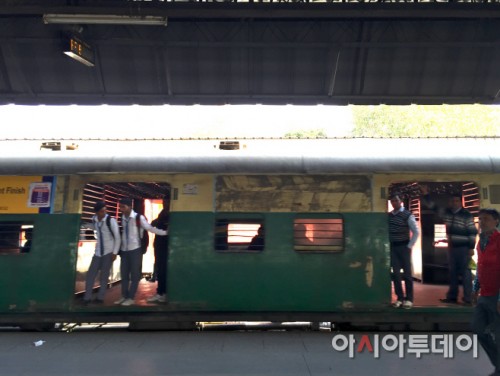China invites journalists and claims that its high-speed railway technology and experiences are ahead of that of France and Japan."
 A local train at New Delhi Station./ Photographed by Ha Man-joo A local train at New Delhi Station./ Photographed by Ha Man-joo |
By Ha Man-joo, India correspondent, AsiaToday - China is making various efforts to obtain orders for building high-speed railways in India and Southeast Asia.
China recently invited journalists from India, Malaysia, Philippines, Singapore, and Indonesia to Beijing, and emphasized that its high-speed railway technology and experiences are adequate for developing countries such as India, reported Indian business magazine Economic Times (ET) on April 23.
While its economic growth is in the slowest pace in 25 years, China is making an aggressive attempt to win its neighboring countries' hearts for building high-speed railways. China has already held a groundbreaking ceremony of a high-speed railway connecting Jakarta and Bandung that would reduce the travel time for the 150 kilometer route to about 45 minutes.
While India's first ever high-speed railway running on a 505-km track between Mumbai and Ahmedabad was given to Japan, China is keen work on other proposed routs. It is carrying out feasibility studies for high-speed lines on the 2,200-km Chenna-New Delhi route and the 1,200-km New-Delhi-Mumbai route.
 The main entrance of New Delhi Station in India./ Photographed by HaMan-joo The main entrance of New Delhi Station in India./ Photographed by HaMan-joo |
The proposed Chennai-New Delhi route could be the second-largest high-speed railway in the world, after the 2,298 km-long Beijing-Guangzhou route, which was launched in 2012.
China claims that its expertise, skills, experience, and ability to execute are ahead of that of Japan, France, and other rival countries. Zhao Guotang, vice general engineer of the China Railway Corporation (CRC), said, "We are confident in our technologies, and we share a lot of similarities with Southeast Asian countries in terms of large population. We want to share our experiences with other countries."
He said, "We are aware of the ongoing debate in India - whether it makes financial sense to go in for expensive high-speed railway when there are so many problems in the existing railway system. Also, whether the high-speed railway will earn profits considering the high price of tickets."
 Suresh Prabhu, Railway Minister of India, explains about the Modigovernment's railroad construction achievement and future plans at 'BengalGlobal Business Summit' held in Kolkata of West Bengal, on January 8, 2016./Photographed by Ha Man-joo Suresh Prabhu, Railway Minister of India, explains about the Modigovernment's railroad construction achievement and future plans at 'BengalGlobal Business Summit' held in Kolkata of West Bengal, on January 8, 2016./Photographed by Ha Man-joo |
According to Zhou, the Nanchang-Shangai line started making profit in the first year of its operation, and the Beijing-Shanghai line in the third year of its operation. He said, it made a profit of over 6 billion RMB (KRW 1.56 trillion) and this year, it is expected to exceed 10 billion RMB (KRW 1.76 trillion).
He also said that average speed of Chinese high-speed railways is faster than that other rival countries. The average operational speed of the Beijing-Guangzhou line is 287 kmph, which is the highest in the world. The second is in France which is 246 kmph and third in Japan at 239 kmph."
He said that China made over 1,000 km of high-speed railways in the past decade while Japan made 350 km and France made 320 km. "For building one high-speed railway, China can finish for 3-5 years, while for some rival countries, it may take 7-8 years," Zhou said.
 Railroad infrastructure comparison chart between India and China from1951 to 2011./ Source from Institute of Competitiveness Railroad infrastructure comparison chart between India and China from1951 to 2011./ Source from Institute of Competitiveness |
India is looking at the situation of China's railway line development with wonder and envy. The first railway line in China was inaugurated in Shanghai in 1876 while in India the first railway line was started in 1836. After India's Independence, in 1951 the total route length in India stood at 53.596 km and China stood at a mere 23,000 km. However, the situation was completely reversed after 69 years. The total route length in China stands at 110,000 km, which is four times higher than in 1951, while India has only increased 11,000 km for the same period.
Most Read
-
1
-
2
-
3
-
4
-
5
-
6
-
7





















